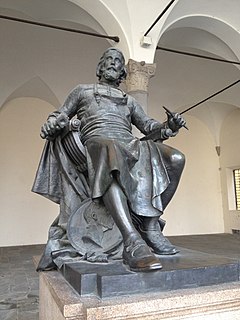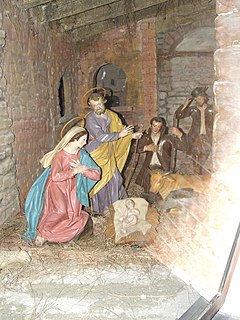Related Research Articles
Giovanni Benedetto Castiglione was an Italian Baroque painter, printmaker and draftsman, of the Genoese school. He is best known now for his etchings, and as the inventor of the printmaking technique of monotyping. He was known as Il Grechetto in Italy and in France as Le Benédette.

Valerio Castello born in Genoa, was an Italian painter of the Baroque period and one of the pre-eminent Ligurian painters of his time. His art drew inspiration from a wide range of sources. He painted on canvas and fresco.
Bernardo Castello (1557–1629) was an Italian painter of the late-Mannerist style, active mainly in Genoa and Liguria. He is mainly known as a portrait and historical painter.

Giacomo Antonio Ponsonelli (1654–1735) was an Italian late-Baroque sculptor.

Giovanni Andrea Ansaldo was an Italian painter active mainly in Genoa.

Giulio Benso was a Genovese painter of the early Baroque. He is known as one of the followers of the style of Luca Cambiasi.

Giovanni Battista Paggi was an Italian painter, sculptor, and writer. His style spans the Late-Renaissance and early-Baroque.

Matteo Civitali (1436–1501) was an Italian sculptor and architect, painter and engineer from Lucca. He was a leading artistic personality of the Early Renaissance in Lucca, where he was born and where most of his work remains.
Giuseppe Badaracco (1588–1657), also called “Il Sordo”, was an Italian painter of the Baroque period, active mainly in Genoa, in Liguria and in the island of Corsica.
Giovanni Domenico Cappellino (1580–1651) was an Italian painter of the Renaissance period, active mainly in his natal city of Genoa. He was the pupil of the painter Giovanni Battista Paggi. At age 22, he painted a Saint Sebastian for the church of Santa Sabina. He contributed a canvas to the Oratory of San Giacomo della Marina. In Genoa, he painted a Death of St. Francis for the church of San Niccolo, and a St. Francesca Romana for the church of San Stefano.

Carlo Giuseppe Ratti (1737–1795) was an Italian art biographer and painter of the late-Baroque period. He was a pupil of the painter Giovanni Agostino Ratti. Born in Savona, he moved to Rome where he befriended Anton Raphael Mengs and Pompeo Batoni. He died in Genoa, where he labored for many years.

Raffaele Motta, known as Raffaellino da Reggio, was an Italian Mannerist style painter from Reggio Emilia, who mainly worked in Rome. He assimilated the style of Taddeo Zuccari and also developed more personal traits. In the last three years of his short life, he worked alongside Lorenzo Sabbatini in works for the Vatican commissioned by Gregory XIII. The Late Mannerist painter and historian Giovanni Baglione considered Raffaellino's early death a significant loss to art.

Sebastiano Galeotti (1656–1746) was a peripatetic Italian painter of the late-Baroque period, active in Florence, Genoa, Parma, Piacenza, Codogno, Lodi, Cremona, Milan, Vicenza, Bergamo, and Turin.

Pellegrino Piola, also called Pellegro Piola or il Pellegro, was an Italian painter of the Baroque period, active in Genoa.
Domenico Bocciardo was an Italian painter of the Baroque period, active in Genoa.Native of Finale Ligure, but died in Genoa. He was a pupil of Giovanni Maria Morandi in Rome, but upon the death of Morandi in 1717, went to Genoa to work. He painted a San Giovanni baptizing the Multitude for the church of San Paolo in Genoa.

Giovanni Maria delle Piane was an aristocratic Genovese who served as primary court painter for over 60 years in the late-Baroque period. He is also known as "il Molinaretto".

Anton Maria Maragliano was an Italian sculptor of the Baroque period, known primarily for his wooden statues. He was born in Genoa, where he led an important workshop.

Giovanni Enrico Vaymer was an Italian painter of the Baroque period.
Bartolommeo Morelli also called il Pianoro, was an Italian painter from the baroque period, active mainly in quadratura and frescoes. He was a pupil of Francesco Albani in Bologna. His main work in Bologna were frescoes in the chapel of the Pepoli Family in San Bartolommeo di Porta. Malvasia refers to him as Bartolommeo Pianoro, who was also active in Genova at the same time as Andrea Sghizzi, another pupil of Albani.

Villa Pallavicino delle Peschiere is a 16th-century villa in Genoa, Northwestern Italy, built in 1560 for the nobleman Tobia Pallavicino. It is situated in via San Bartolomeo degli Armeni 25, in the quarter of Castelletto, in an area that, at the time when the villa was built, was still outside of the city walls. After the urban expansion of the 19th century, it is now located in the center of the city. The villa still belongs to the Pallavicino family.
References
- ↑ Studi su Raffaele Soprani, Artibus et Historiae, Volume 13, Number 26, (1992), article by Jan K Ostrowski, page 177.